25 Armoire Design Styles (Types, Uses & Pictures)

The word armoire brings to mind tall, ornate furniture with recognizable styles such as the rich swirls of Victorian furniture, the twisted details of Gothic and today’s clean-lined contemporary designs. An armoire was commonly used in a bedroom to store clothing. Even though it’s still an excellent choice for an overflowing closet, it’s really a multifunctional piece of furniture that can be used to store just about anything. Keeping your home or office neat includes de-cluttering and putting things away to create a more organized environment. An armoire provides the space to do that with the style to match your décor. Read this informative article to learn what an armoire is, the many types and styles, the materials used, and how to restore and repurpose one. We’ll cover all the many possibilities this versatile piece of furniture offers your home or office.
What Is An Armoire?
Armoires, with their multi-configured storage solutions, were designed initially as cabinets to store weapons. By the 17th century, nobles decided to use them to hold their royal clothing instead of keeping clothing in a stuffy chest. Today, armoires are known for storing anything from jewelry and craft supplies to linens, sheets, towels, clothing, and accessories. Tall and stately, these cabinets make a statement in any room and are commonly free-standing.
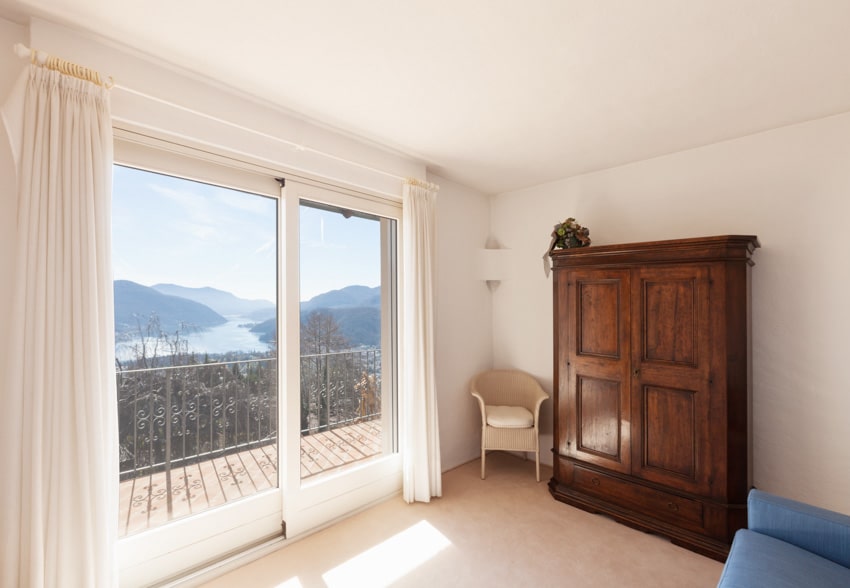
Standard armoires have a rod for hanging clothing, pull-out drawers, shelves, and two doors that open out. Doors can also be made to slide, and mirrors can often be placed on the outside for dressing. They can be custom-designed types of furniture pieces, or their interior can be rearranged according to where someone needs the most space. Usually, vintage armoires are restored and repurposed, finding their way into many types of rooms in a home.
Types Of Armoires
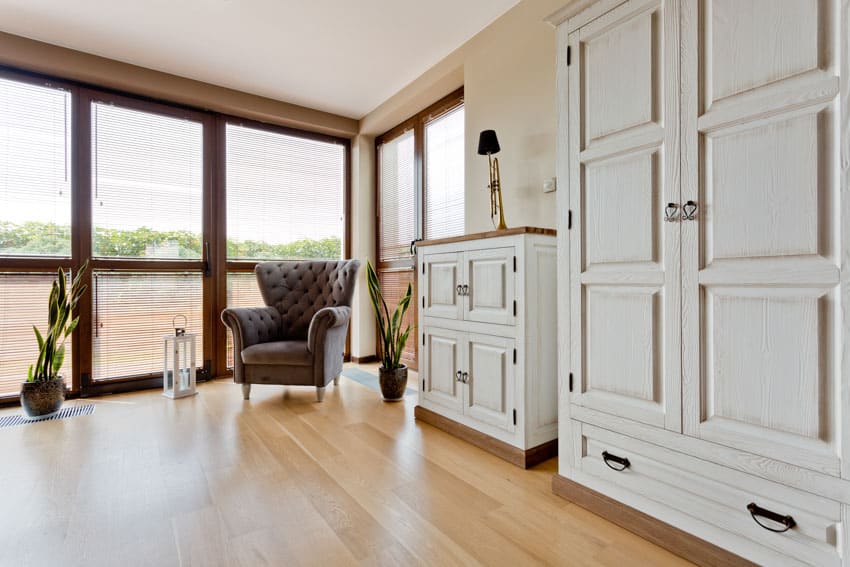
Armoires provide tall, spacious cabinets for storing anything from clothing to kitchen utensils and pantry items. An armoire takes up mostly vertical space, working well for homes and rooms with limited space. There are many uses for these versatile pieces of furniture, affording home and office designers to use armoires in almost any room.
Armoire Wardrobe

An armoire wardrobe usually represents a bedroom piece that’s a large, free-standing cabinet with doors that open to reveal shelving or hanging spaces for clothes and other items. Wardrobe armoires are commonly found in master bedrooms and can be free-standing or built into a wall. They also provide a place for extra lines and pillows and help to keep a bedroom free of clutter for a comfortable and calming environment.
Armoire Dresser

An armoire dresser is a type of cabinet that combines the function of a dresser with that of an armoire. It typically has drawers for storing clothing, certain types of shelves, and cubbies for storing other items such as linens, shoes, accessories, or other apparel. Armoire dressers aren’t typically tall and don’t usually offer a rod for hanging clothing. These handy pieces of furniture are an upgrade from a single dresser.
Jewelry Armoire
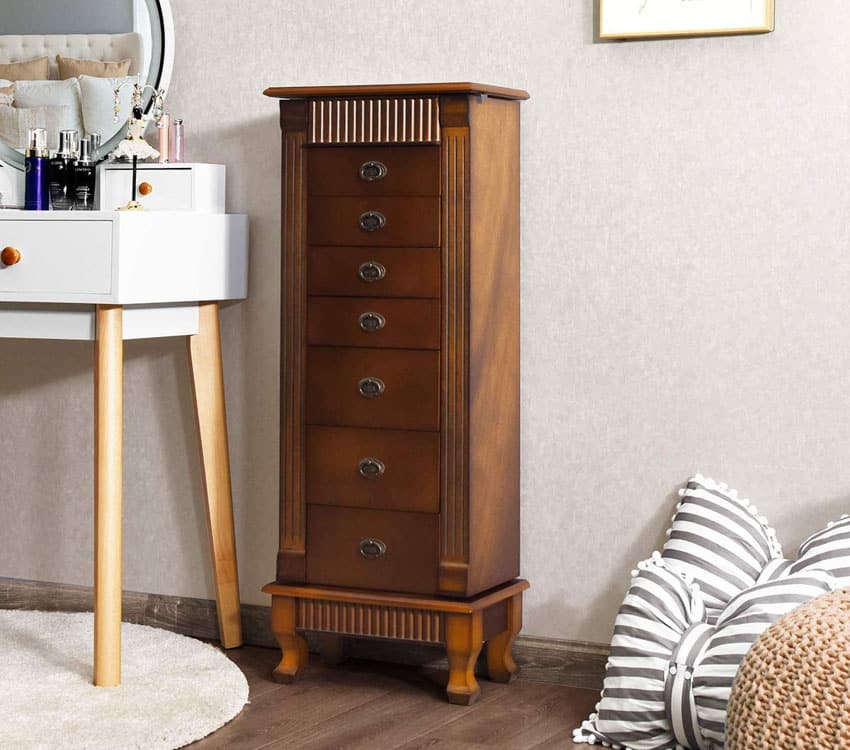
Jewelry armoires are specifically designed to store and organize jewelry. Jewelry armoires can come in a wide range of styles and sizes and can be made from a variety of materials, including wood, metal, and plastic. They typically have multiple drawers and compartments and may also have a mirror. Many jewelry armoires also provide a spot to hang necklaces and can include trays, drawers, and hooks to hold bracelets, rings, and earrings.
Jewelry armoires are usually lined with velour or other soft fabrics to protect fragile jewelry pieces. If you’re concerned about security, look for one with a lock and key option.
Wall Mounted Jewelry Armoire
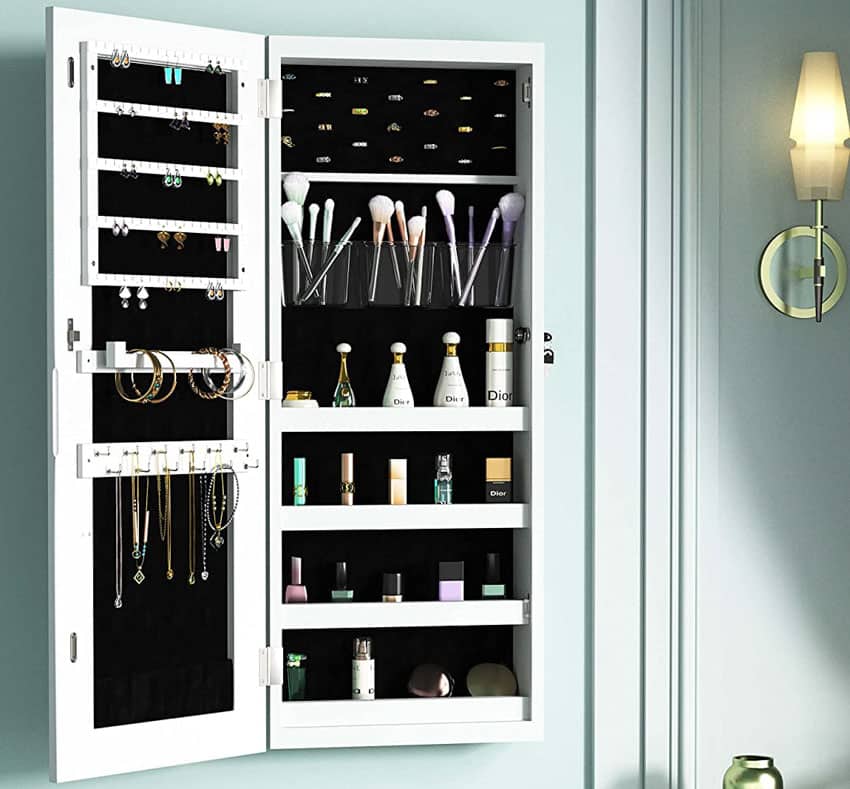
A wall mounted jewelry armoire is mounted on a wall and often used in small spaces where a traditional jewelry armoire would not fit. Wall mounted jewelry armoires come in a variety of styles, including mirrored options that don’t use any floor space at all. Their space-saving design and multiple storage options are perfect for smaller jewelry pieces.
Armoire Desk
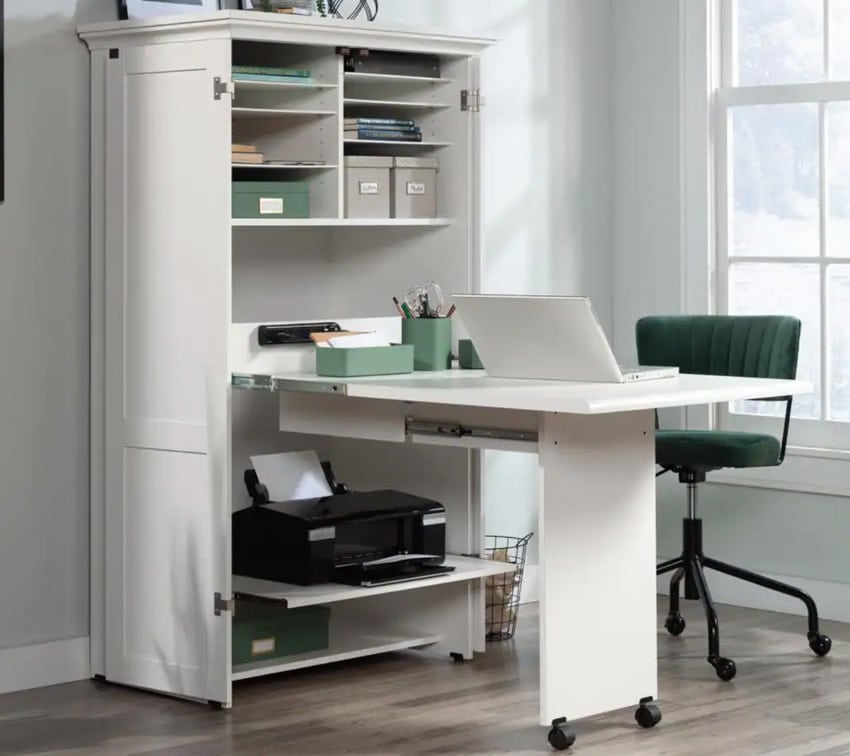
An armoire desk is a type that is typically characterized by its tall, vertical structure and storage space. These types of desks are often used in home offices, as they provide ample storage for office supplies and equipment. Many armoire desks also feature built-in shelving and drawers, making them ideal for storing paperwork and other materials. An upper shelf corrals reference books, magazine holders, and built-in cubbies that are great for storing pencils, pens, scissors, and letter openers.
Computer Armoire
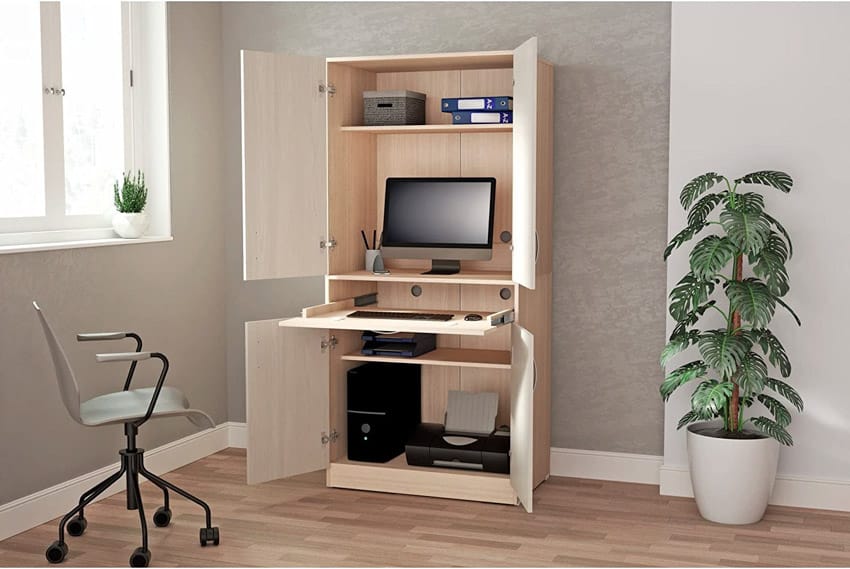
Sometimes called a hutch or secretary, a computer armoire is a tall, narrow cabinet with shelves and doors designed to hold a computer, printer, and other office supplies. A computer cabinet typically has a drop-down desk or work surface, making it an excellent choice for small spaces. The back panel typically has pre-drilled holes to run wires and cables to power the computer and other peripherals. These functional armoires are great for those who work at home, allowing a complete space to work and store supplies without using an entire room as an office.
TV Armoire
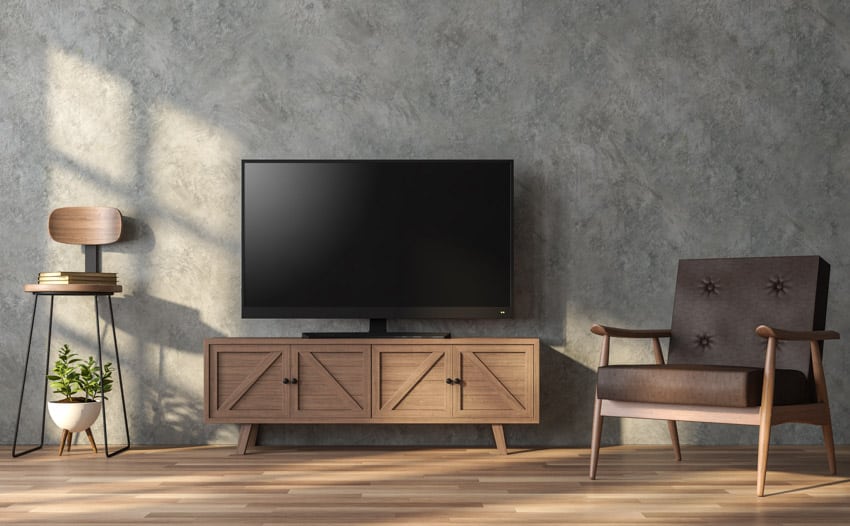
A TV armoire provides a place for a television, speakers, video game systems, tablets, and storage for DVDs and other forms of movies and shows such as VHS and Blue-Ray. Most TV armoires only have a television platform but can be designed to store all your media devices for easy access. They also come with holes in the back for wires, power cords, and cable connections. These pieces are great for having one place to keep all the associated remotes, and the front doors conceal the TV and all devices when not in use.
Mirror Armoire
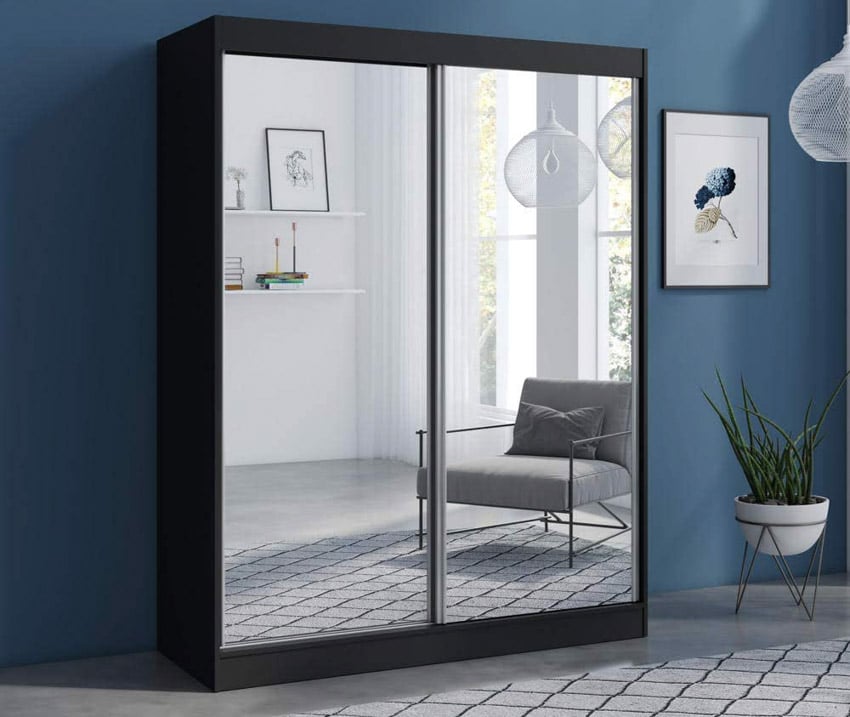
Mirror armoires commonly have mirrored doors on the outside or mirrors on the inside of the doors and make a convenient dressing area. The full-length mirrors make it easy to get dressed by not having to go between your vanity and armoire.
Craft Armoire
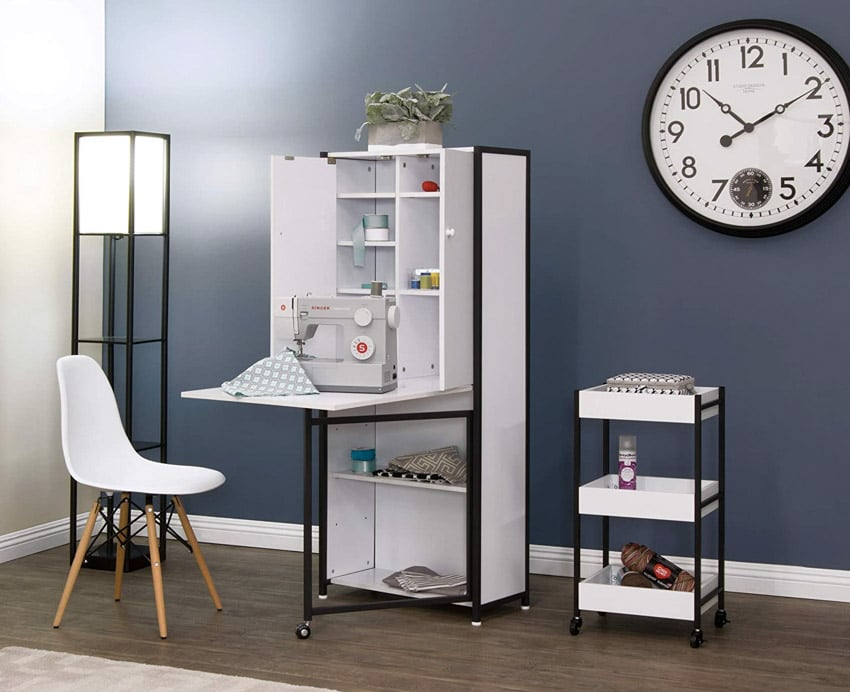
For those who love crafting, a craft armoire is a great organizer for keeping all the many items and accessories used to make crafts. From beads, connectors, glue guns, tools, and supplies, craft cabinets help keep everything easy to find and organized. Many craft room armoires include a pull-out table to work on.
Modern Armoire

Styles from Scandinavian, Danish, and Swedish designers create a modern furniture design recognized by rounded contours, clean lines and ergonomic elements. Modern armoires reflect contemporary characteristics with simple materials and bold colors. These sleek pieces reflect a homeowner’s grasp of modern concepts and create a calming feel in homes with clean-lined décor.
Boho Armoire
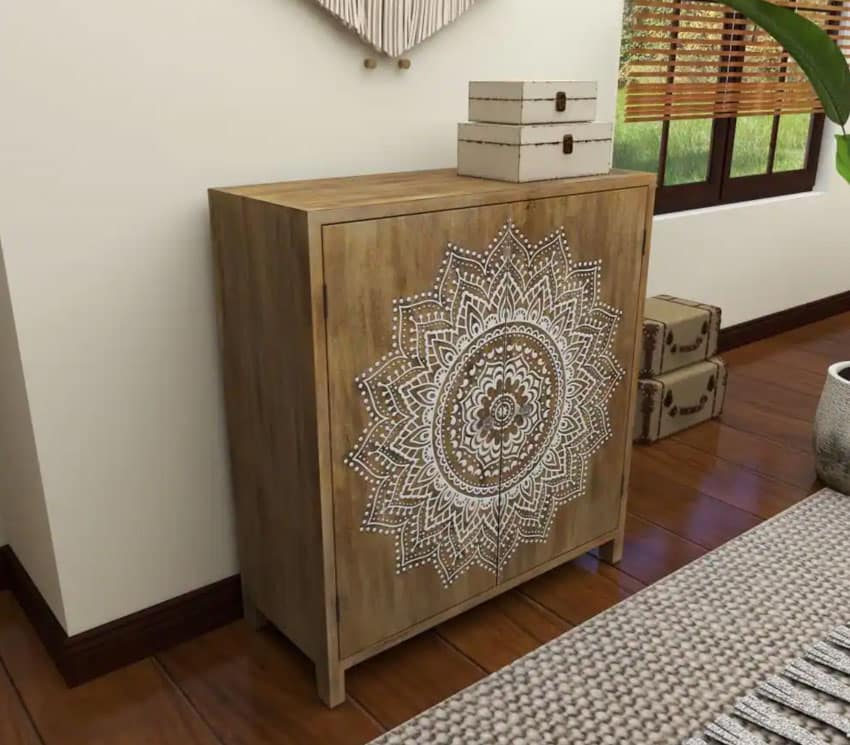
Add a Bohemian style to your home with a Boho armoire. Bohemian-styled furniture includes intricate carvings and is often adorned with mandala patterns. The mandala is considered a spiritual symbol representing sacredness and peace. Boho armoires have crisp lines and an artistic look reminiscent of an eclectic mix of natural elements.
DIY Armoire
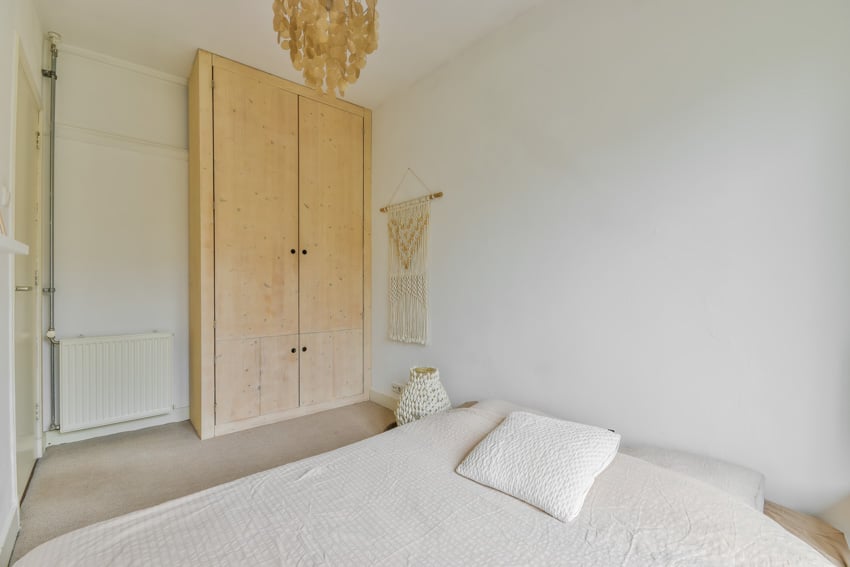
Often, hand-made furniture enthusiasts decide to build a DIY armoire. Countless plans can be found online and in books and magazines using materials like wood, manufactured wood, mixed materials, and wicker. DIY means the armoire can be designed with a custom configuration, and depending on the material used, it can be stained, painted a solid color or combination of colors, or painted with a base coat and then decorated with hand-painted scenery.
Armoires can be purchased at estate sales, vintage used furniture stores, and thrift shops. Repairs are done; stripping the material allows for a custom finish, and upgrades to hardware result in a custom DIY piece. One of the easiest DIY armoires is to simply add two doors on the front of a bookshelf, creating perfect storage for pantry items, shoes, magazines, or kitchen tools.
Shoe Armoire
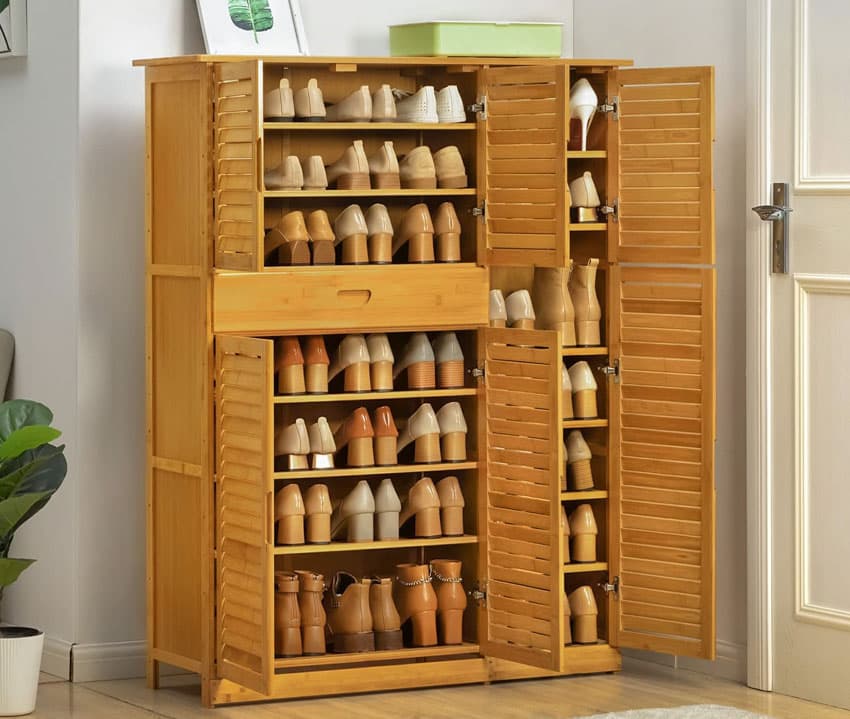
A shoe armoire is used to store shoes either for one person or an entire family. Shoe armoires contain divided cubbies for pairs of shoes and often include loops to hang dresses or snow boots. These can be the best shoe storage solution for those who own any pricey pairs of shoes. Many shoe armoires feature slatted doors that allow control over the temperature, but they also keep the closet’s interior pretty dark to protect more expensive shoes.
Armoire Features
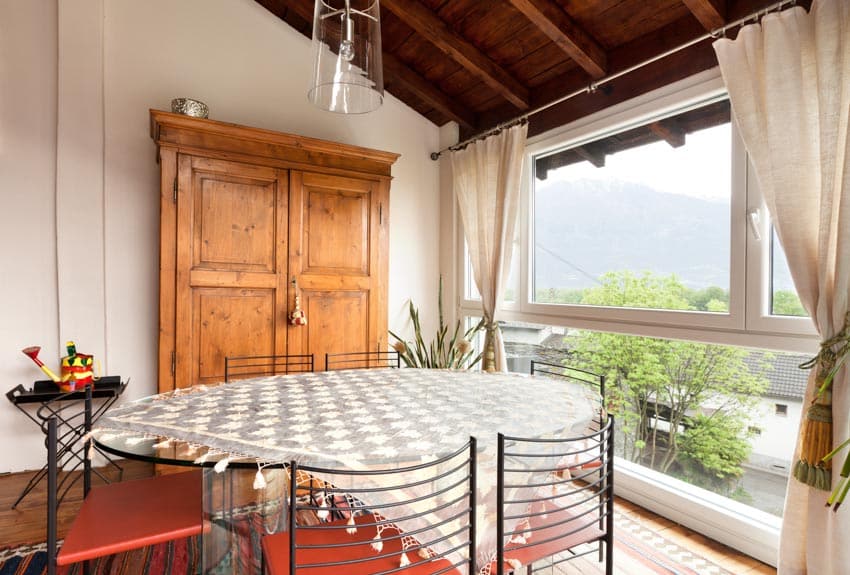
An armoire offers expanded storage space and includes features to meet the needs of different applications. These versatile furniture pieces provide space to keep things neat and organized and hidden from sight in a home or office.
Drawers: Unlike a wardrobe with only a rod to hang clothing, an armoire includes drawers to store items. Anywhere from 2 to 8 drawers is an average number, allowing organization and easy-to-find storage. Most drawers have ball-bearing guides for smooth operation and come with linings such as felt and cedar to protect items from moisture and dust.
Shelving: Shelving can accommodate items such as paperwork, magazines, and books or can be used to store shoes, sentimental items, or other personal belongings. Shelves may be configured to hold storage items or media devices, as with a TV armoire, and come in handy for storing boxes of photos or letters.
Clothing Racks: Most armoires only have one clothing rack to hang items, and they are typically mounted at the top of the armoire with clearance to the bottom for long items such as gowns and coats. Several racks can be mounted to hang pants or tops and must be placed so they leave enough room for the length of hangers.
Double Doors: Armoires typically have double doors that open out but may include two short doors on one side and a full-length door on the other. There are endless combinations with wider units having three or four doors across.
Sliding Door Armoire: For an easy way to access your belongings, sliding doors allow you to slide either door on a built-in track smoothly. Most sliding doors have a bottom track, but for a stylish addition, sliding doors can slide on a top track. Some examples that can be used are barn-style hardware pieces. An entry piece with sliding doors makes it easier to access when there isn’t a lot of room to open doors outward.
Standing Mirror: A standing mirror armoire is commonly used for jewelry and includes inside storage such as necklace hooks, cubbies, shelves, bracelet rods and storage for rings and earrings.
Standing mirror armoires are made the same size as jewelry units and have a front mirror the entire length of the piece to give a complete view of your outfit and jewelry accessories. Many standing mirror armoires have an adjustable tilt and lockable door and can be stored in a closet or used as a decorative display.
Armoire Materials
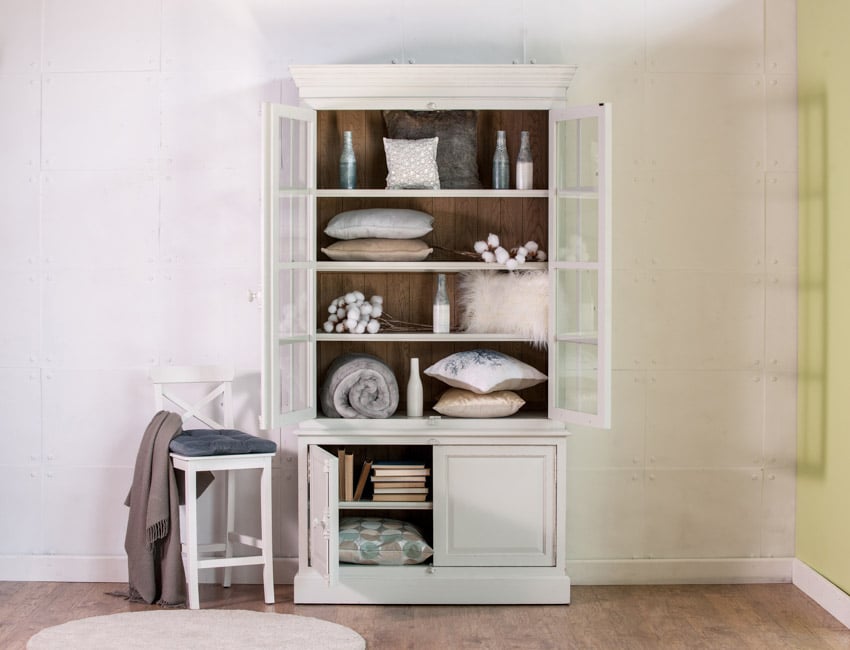
Armoires come made with different materials according to their use and when they were designed and built. Early armoires were often made from mahogany, oak, and hardwoods and were heavy pieces typically adorned with ornate carvings. Today’s products aren’t as heavy and can be found in several materials.
Wood: The material of choice for a long-lasting and durable armoire is solid wood. Natural wood holds its shape, is resilient against dampness, can be refurbished easily, and wears well. Solid wood units last for countless years, and although they are heavy, the timeless look of wood never goes out of style.
During the 17th and 18th centuries, the French used only indigenous wood to build these pieces, including oak. However, like in the American colonies, oak wood was ravaged, so furniture builders shifted to walnut wood.
Many Amish furniture builders favor hardwoods for building armoires, including mahogany. Mahogany is more flexible than many hardwoods and less brittle. Its naturally rich, deep red-brown hue and straight grain look stunning under a satin finish, providing an old-world look.
The Shakers often use regional wood from maple, oak, walnut, and cherry trees. These timeless choices create fine furniture like armoires that provide exquisite colors, sturdy options, and beautiful patterns. Many furniture manufacturers also embrace reclaimed wood using white pine barn wood, chestnut, and oak.
Wood Composite: To create affordable armoires without sacrificing size and design, manufacturers often turn to wood composites. These fabricated wood alternatives include a variety of mixed material wood products, such as sawmill scraps from wood waste, thermoplastic resin, and wax.
Often, wood composite is labeled medium-density fiberboard, or MDF. Additional materials added to the mix can include UV stabilizers, coupling agents, colorants, and lubricants.
Armoires made with wood composite are less expensive and provide sturdy substitutes for solid wood, and the finishes used will recreate the beautiful look of wood. Wood composite, however, is more susceptible to damage from water and moisture exposure.
Rattan: Rattan is a material made from rattan vines woven together to create furniture. The rattan can be natural or synthetic, with synthetic rattan being used more for outdoor furniture. Rattan armoires provide a classic texture, are sophisticated and always in style. Rattan comes naturally in grays, browns, and blacks and can be painted in other colors to match your design and style.
Rattan armoires are not as heavy as solid wood, but even though they are lighter materials, they are equally durable and long-lasting. Hardwood cabinets are challenging to move, but rattan units are easily slid on a smooth surface or carried.
Natural rattan is easy to clean but is prone to mold if exposed to long-term moisture. An old toothbrush is a great way to reach in grooves and crevices to remove dirt and dust. Always wipe dry after cleaning and remove stains immediately.
Wicker: Wicker is a weaving process that creates a distinctive pattern. Wicker armoires are made from several material choices, including willow, reed, rattan, and bamboo, and wicker can also be made from synthetic materials for outdoor use and patio furniture. As with its cousin rattan, wicker is durable and lighter than natural wood, and it’s easy to move.
The materials used for wicker are woven together using vines, grass, and plants. Although wicker types of furniture look similar to rattan furniture, the two are technically different; rattan is used to make wicker, but rattan also stands alone when used to make furniture such as armoires. Read more about rattan vs wicker here.
Armoire Vs Wardrobe
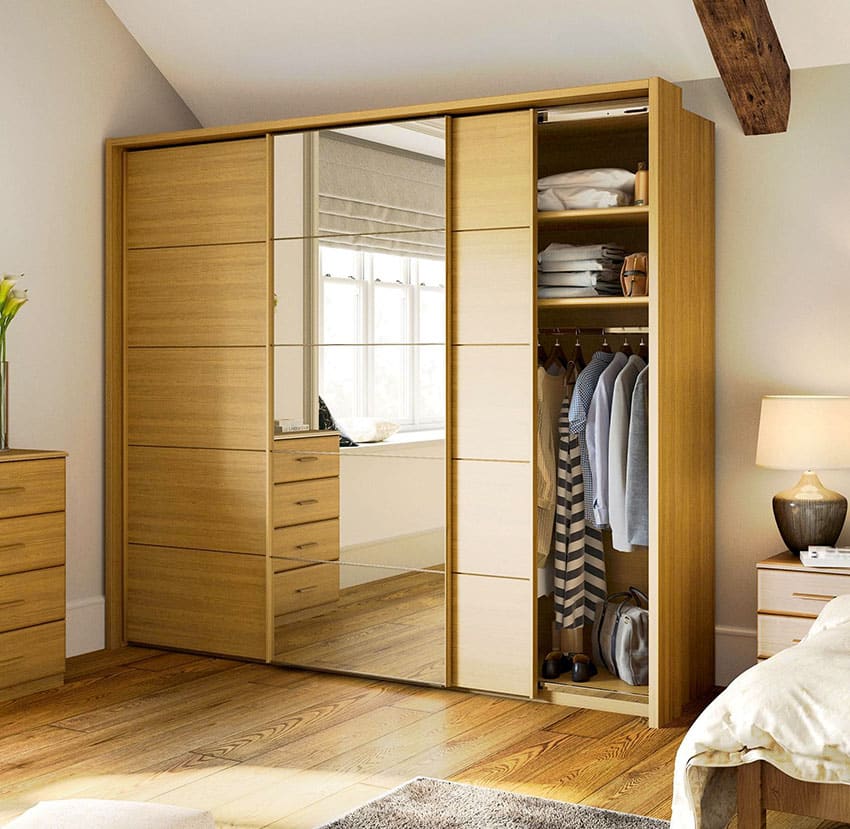
While an armoire is a tall, free-standing cabinet with doors, a wardrobe is more commonly used for hanging clothing or long coats and outfits. Both pieces of furniture can accommodate hanging clothing, making each fall into a wardrobe category. However, an armoire includes other types of storage space, including drawers, shelves, and cubbies. Armoires, compared to wardrobes, are customizable and adaptable, creating organized storage for almost any item. Often, wardrobes are used to store clothes made from delicate fabrics or real furs that require specific humidity levels, a dark environment, and protection from dust and dirt. Read about how wardrobes compare to closets here.
Armoire Makeover Ideas
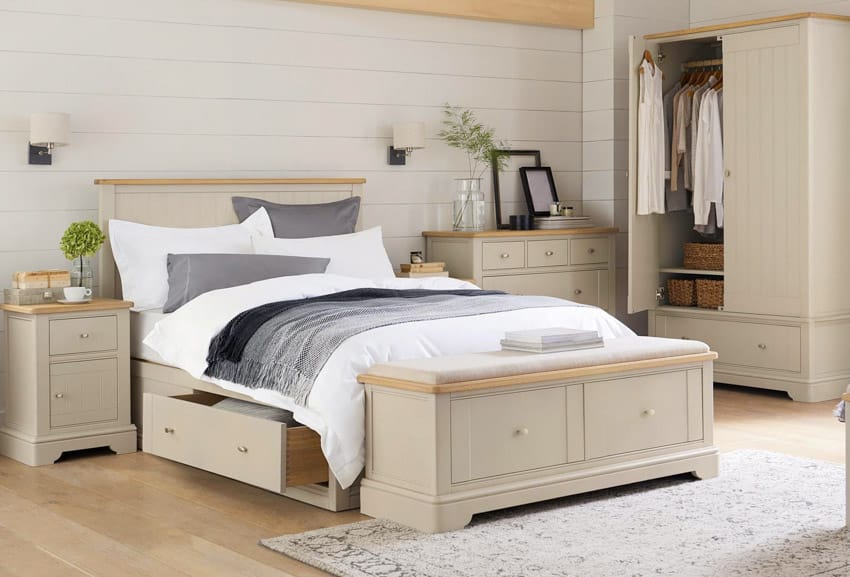
If you want to change up a room while creating storage space, used armoires can be purchased online, at estate sales, or at neighborhood garage sales. Often, you can purchase one for a great price when it needs to be restored or refinished. Depending on the original finish, some sanding and smoothing of the wood, along with a new coat of stain, can renew a vintage piece. Adding new knobs, hinges, and drawer pulls will also provide some exciting touches. Many people enjoy painting armoires and adding a designs such as floral arrangements, art deco artwork, landscapes, or natural scenery to match their home décor.
Armoires can also be repurposed by rearranging draws and shelves or removing all the interior hardware to create storage for long dresses, evening gowns, formal attire, or coats. Once hollowed out, you can use a larger piece to create a private home office spot or a craft workspace. An armoire with the front doors removed can serve as a bookcase or a display case for artwork or figurines and comes in handy when used as a place to hang keys, coats, and store boots by an entryway.

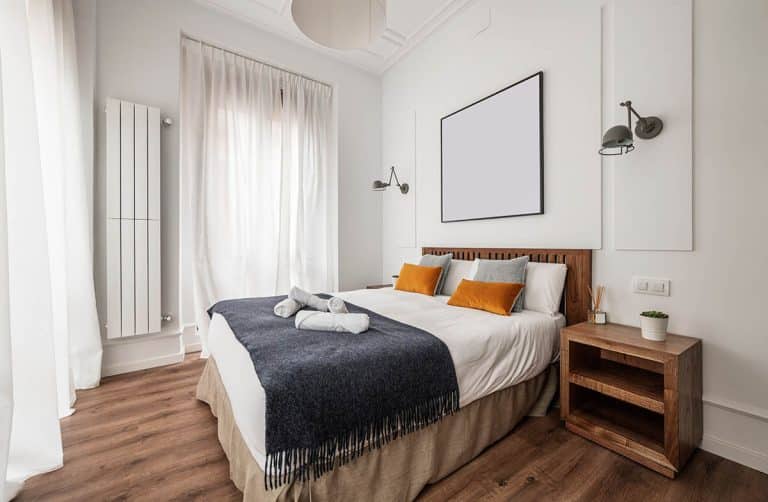
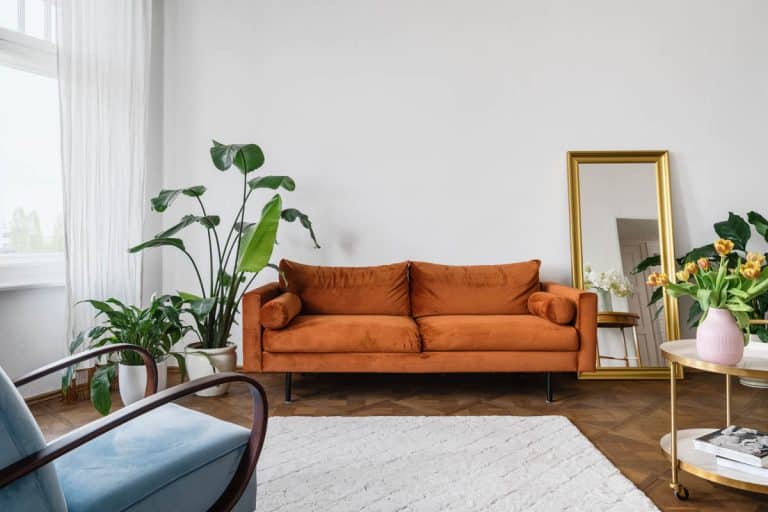


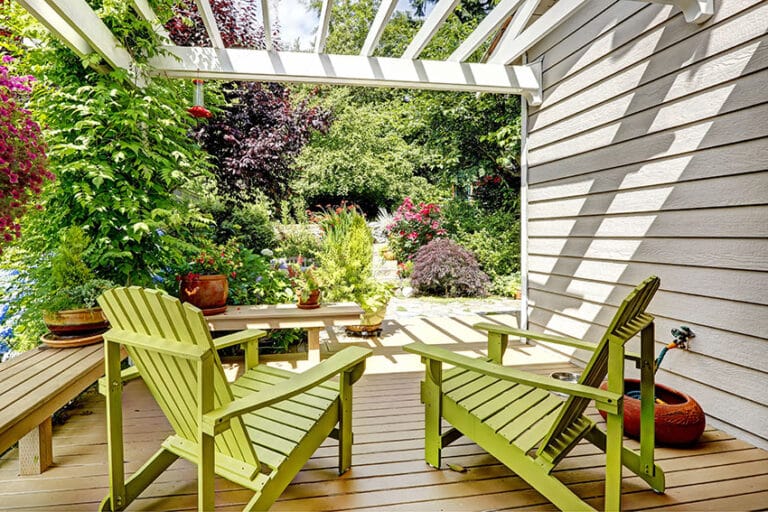
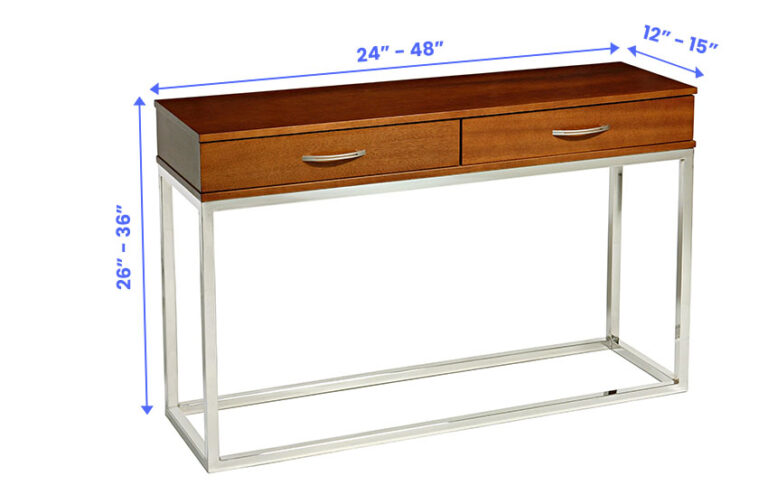
Thank you for all the details. You covered everything I was wondering about.